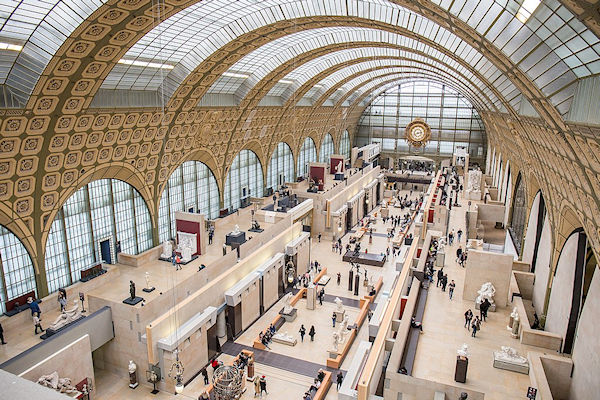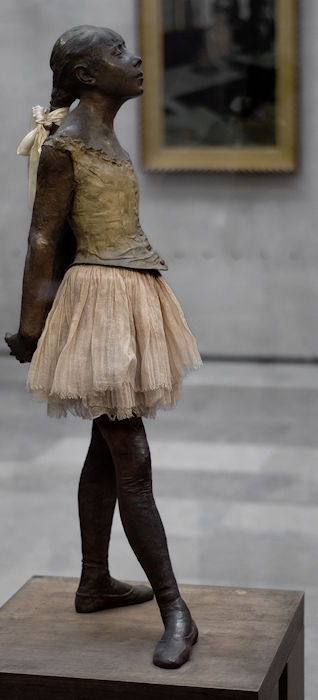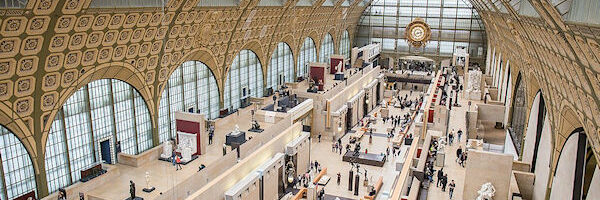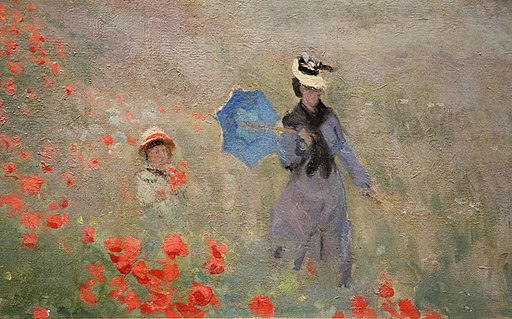History
Although Musee d’Orsay boasts very impressive arts pieces from predominantly around the mid-nineteenth to twentieth centuries, the museum is also known for its architectural significance.

Before it was transformed into a museum, Musee d’Orsay was originally built in 1810 as a train station that welcomed visitors for the 1900 Universal Exhibition. This train station design can still be seen today in the high arched ceiling and the grand clock that hangs at the entrance of the museum.
Key Terms:
- Impressionism – This style of painting that was developed in France (mid-to-late 1800). This style gives an ‘impression’ of form.
- Claude Monet – A famous French Impressionist artist who lived from 1840 – 1926.
- James Abbott Whistler – American and British Impressionist and Realist painter (1834 – 1903)
- Tonalism – A style of painting where the background color is limited and blended to give a dreamy effect.
- Modernism – A global cultural movement that affected arts and literature in the twentieth century.
- Realism – Realism started in France in the 1840s, as a way of replacing idealistic art with realistic images.
- Aestheticism – An art movement that emphasizes that art can exist for beauty values alone.
- Auguste Rodin – A French sculptor who lived from 1840 – 1917.
- Pierre-Auguste Renoir – A French painter who helped to launch the Impressionist movement in the late nineteenth century.
Styles
As it is known mostly as an Impressionist museum, many beautiful and original Impressionist paintings fill the walls. The greatest and most famous of Impressionist artists are included in this collection – including Claude Monet, James Abbott Whistler, and Pierre-Auguste Renoir.
Artwork

Many famous, elaborate, and beautiful paintings and statues grace the four floors of this exquisite museum! The painting styles include (but are not limited to) – Impressionism, Modernism, Realism, and Tonalism.
Of particular note is Edgar Degas’ The Little Fourteen-Year-Old Dancer.
You will need:
- Paper and/or some type of blank canvas
- Citrus colored acrylic paint like
- An outline of an orange in a bowl or real-life oranges in a bowl on the table.
- Pencil
- Paint brushes
Works Cited:
- “Auguste Rodin.” Artist Info, https://www.nga.gov/collection/artist-info.2251.html.
- “How Far Would You Go to See the World’s Best Works of Art?” Houstonia Magazine, Houstonia Magazine, 26 Apr. 2019, https://www.houstoniamag.com/travel-and-outdoors/2019/04/traveling-just-to-see-famous-art.
- “James Abbott Mcneill Whistler – Artist Gallery of Career Highlights.” James Whistler Paintings, Prints & Artwork, https://www.jameswhistler.org/.
- “Musée D’Orsay in Paris – History, Facts and Tips.” Come to Paris, 1 Jan. 1065, https://www.cometoparis.com/paris-guide/paris-monuments/musee-d-orsay-s952.
- “Oscar-Claude Monet.” Claude Monet – The Complete Works, https://www.claudemonetgallery.org/.
- Ototo, et al. “History of the Musée D’orsay: From Parisian Train Station to World-Class Art Museum.” My Modern Met, 2 Feb. 2019, https://mymodernmet.com/musee-d-orsay-history/.
- “Pierre-Auguste Renoir.” Biography.com, A&E Networks Television, 28 Oct. 2021, https://www.biography.com/artist/pierre-auguste-renoir.
- “Realism Movement Overview.” The Art Story, https://www.theartstory.org/movement/realism/.
- Sotheby’s. “Impressionism.” Sothebys.com, Sotheby’s, 14 Jan. 2020, https://www.sothebys.com/en/art-movements/impressionism.
- Tate. “Aesthetic Movement – Art Term.” Tate, https://www.tate.org.uk/art/art-terms/a/aesthetic-movement.
- Tate. “Modernism – Art Term.” Tate, https://www.tate.org.uk/art/art-terms/m/modernism.
- “What Is Tonalism? Tonalism Palette, Tonalism Definition.” Tonalism, https://www.tonalism.com/what-is-tonalism.
- Zajac, Mary, et al. “How James McNeill Whistler Became a Brand and Fought for It in Court.” The National Endowment for the Humanities, https://www.neh.gov/humanities/2014/septemberoctober/feature/how-did-james-mcneill-whistler-create-his-distinctive-brand.


